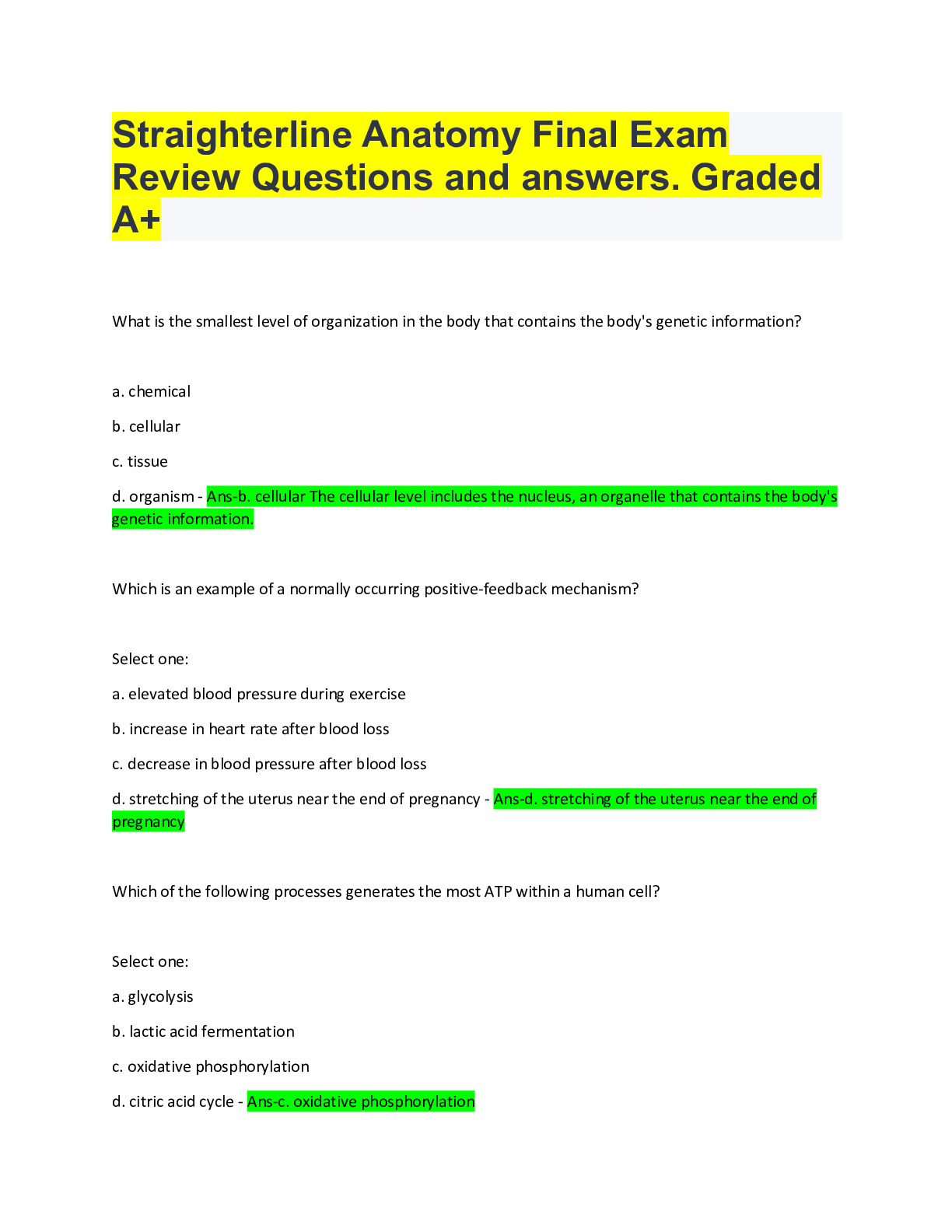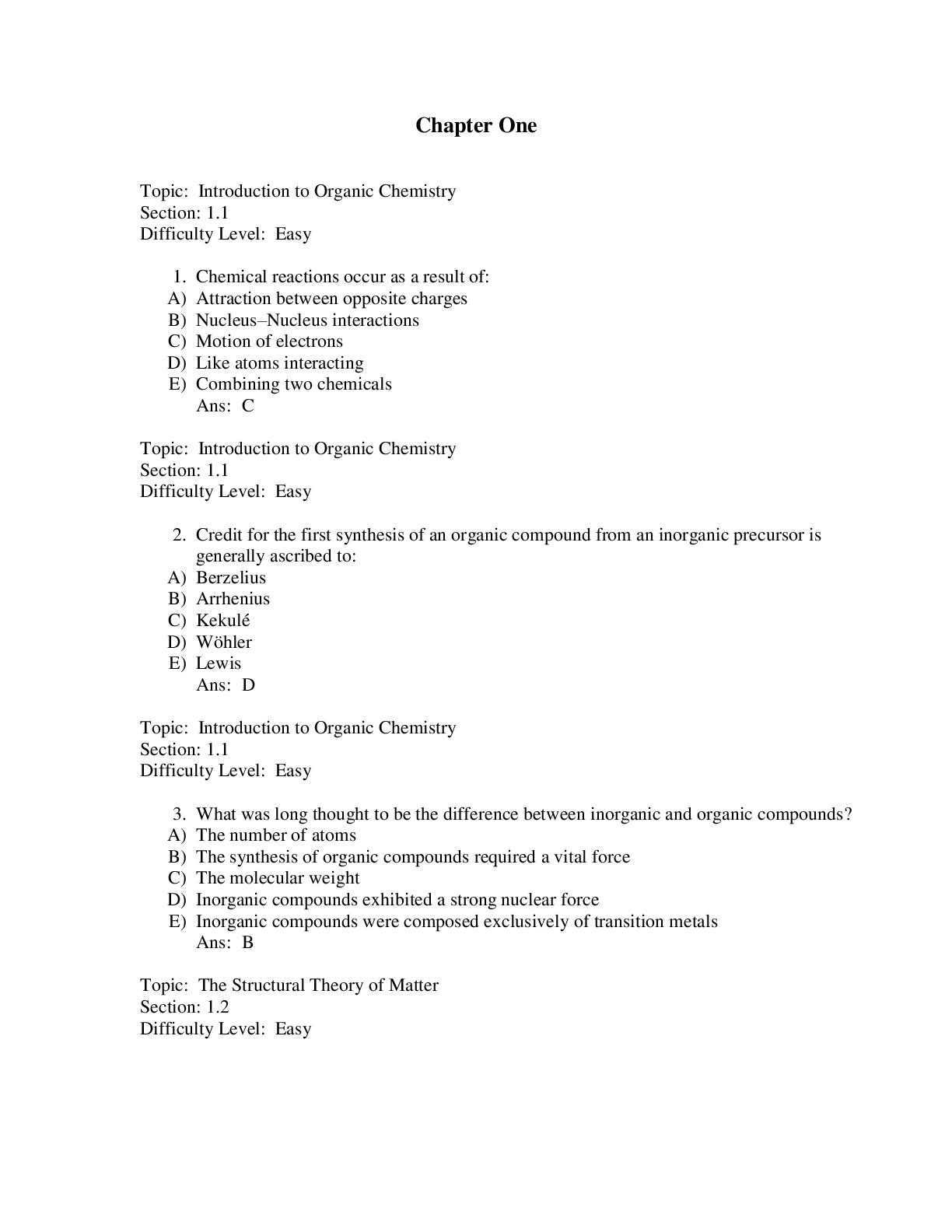Anatomy > QUESTIONS & ANSWERS > Straighterline Anatomy Final Exam Review Questions and answers. Graded A+ (All)
Straighterline Anatomy Final Exam Review Questions and answers. Graded A+
Document Content and Description Below
What is the smallest level of organization in the body that contains the body's genetic information? a. chemical b. cellular c. tissue d. organism - Ans-b. cellular The cellular level includes ... the nucleus, an organelle that contains the body's genetic information. Which is an example of a normally occurring positive-feedback mechanism? Select one: a. elevated blood pressure during exercise b. increase in heart rate after blood loss c. decrease in blood pressure after blood loss d. stretching of the uterus near the end of pregnancy - Ans-d. stretching of the uterus near the end of pregnancy Which of the following processes generates the most ATP within a human cell? Select one: a. glycolysis b. lactic acid fermentation c. oxidative phosphorylation d. citric acid cycle - Ans-c. oxidative phosphorylation During DNA replication, how does each template strand eventually become two identical DNA molecules? Select one: a. The two strands form continuously, catalyzed by DNA polymerase. b. The two strands form continuously, catalyzed by DNA ligase. c. One strand forms continuously, the other forms in short segments spliced by DNA polymerase. d. One strand forms continuously, the other forms in short segments spliced by DNA ligase. - Ans-d. One strand forms continuously, the other forms in short segments spliced by DNA ligase. There is a leading strand and a lagging strand; they don't both form continuously. Which is the most superficial layer of skin that is composed primarily of living cells? Select one: a. stratum corneum b. stratum lucidum c. stratum basale spinosum. d. stratum spinosum - Ans-. d. stratum spinosum (stratum basale layer is below the stratum spinosum) Which of the following is the definition of a third degree burn? Select one: a. a burn that covers at least 25% of the skin b. a burn that has destroyed the dermis and epidermis c. a burn that can only be caused by fire d. a burn that does not leave scars - Ans-a burn that has destroyed the dermis and epidermis. How much skin the burn covers does not definite which degree of burn it is. Which of the following types of openings in the skeletal system does a "sinus" describe? Select one: a. cavity b. cleft c. hole d. tunnel - Ans-a. cavity: a sinus is an air space within bone. Which of the following components of the bone matrix, when removed, allows the bone to be easily shattered? Select one: a. cartilage b. collagen c. hydroxyapatite d. mineral - Ans-b. Collagen is a component of the bone matrix that gives it flexible strength so it is less brittle. Which of the following is the most widely distributed type of muscle in the body? Select one: a. cardiac b. postural c. skeletal d. smooth - Ans-d. smooth Which sentence best describes the sliding filament model of muscle contraction? Select one: a. Actin and myosin filaments remain stationary. b. Actin and myosin myofilaments shorten. c. Sarcomeres and myofibrils contract. d. Sarcomeres and myofibrils lengthen. - Ans-c. Sarcomeres and myofibrils contract. The shortening of sarcomeres is responsible for contraction, and thus myofibrils (sarcomeres joined end to end) also shorten A doctor performing an autopsy on a patient concludes that part of the brain was likely damaged by trauma due to a large population of which type of cell? Select one: a. Schwann cells b. microglia c. oligodendrocytes d. ependymal cells - Ans-b. microglia What type of axons is found in a gray ramus comunicans? Select one: a. myelinated, pre-ganglionic axons b. myelinated, post-ganglionic axons c. unmyelinated, pre-ganglionic axons d. unmyelinated, post-ganglionic axons - Ans-d. unmyelinated, post-ganglionic axons Which class of chemical messengers is secreted by neurons into synaptic clefts to activate an adjacent cell? Select one: a. autocrine b. endocrine c. neurotransmitter d. paracrine - Ans-c. neurotransmitter Neurotransmitters are secreted into a synaptic cleft by presynaptic nerve terminals. The targeted response of the hormone lipotropin is an increase in which of the following? Select one: a. the breakdown of fat in adipose tissues b. the breakdown of lipids and release of fatty acids from cells This is caused by release of growth hormone. c. the production of milk in lactating women d. the secretion of thyroid hormone - Ans-a. the breakdown of fat in adipose tissues What causes the breakdown of lipids and release of fatty acids from cells? - Ans-The release of growth hormones. There are more microbial cells than human cells in your body and the health of this microbiota clearly influences human well-being. How many microbes are there?. Select one: a. For every cell in your body, there are ten microbial cells. b. For every cell in your body, there are one hundred microbial cells. c. For every cell in your body, there are one thousand microbial cells. d. For every cell in your body, there are ten thousand microbial cells - Ans-a. For every cell in your body, there are ten microbial cells. The study of the body's organization by areas is Select one: a. systemic anatomy. b. regional anatomy. c. molecular biology. d. microbiology. e. surface anatomy. - Ans-b. regional anatomy. The popliteal region is the Select one: a. calf. b. armpit. c. hollow behind the knee. d. neck. e. thigh. - Ans-c. hollow behind the knee. Deep means Select one: a. toward the middle or midline of the body. b. away from the surface. c. closer to the head. d. closer than another structure to the point of attachment to the trunk. e. toward the back of the body. - Ans-b. away from the surface. The gluteal region is commonly known as the Select one: a. groin. b. buttock. c. breastbone. d. upper arm. e. naval. - Ans-b. buttock. An electrolyte is Select one: a. a combination of atoms held together by chemical bonds. b. a positively charged ion. c. a negatively charged ion. d. a substance that conducts electricity when placed in solution. e. the alteration in the three-dimensional structure of a protein. - Ans-d. a substance that conducts electricity when placed in solution. A buffer will Select one: a. enhance changes in the pH of the solutions. b. resist drastic changes in the pH of the solutions. c. have no effect on the pH of the solutions. d. make a solution more acidic. e. make a solution more basic. - Ans-b. resist drastic changes in the pH of the solutions. What is the building block molecule of a protein? Select one: a. amino acid b. nucleic acid c. monosaccharide d. glycerol e. fatty acid - Ans-a. amino acid Fatty acid A has 10 double covalent bonds scattered throughout its carbon chain while fatty acid B has only single covalent bonds between the carbons in its chain. Select one: a. Fatty acid A is saturated. b. Fatty acid B is unsaturated. c. Both fatty acids are saturated. d. Both fatty acids are unsaturated. e. Fatty acid B is saturated. - Ans-e. Fatty acid B is saturated. What is the definition of a Saturated fat ? - Ans-A saturated fat contains only single covalent bonds between carbon atoms. Examples: Beef, pork, milk, cheese, butter, eggs, coconut oil What is an unsaturated fatty acid? - Ans-It has one or more double covalent bonds within the carbon chain, and between carbon atoms. They stay liquid at room temperature. Electrolytes are substances that Select one: a. form covalent bonds with water. b. conduct electricity when dissolved in water. c. cannot conduct electricity in solution. d. are NOT found in the human body in any appreciable amounts. e. are NOT charged particles. - Ans-b. conduct electricity when dissolved in water. A runner produced hypotonic sweat while running a marathon in hot weather. After the race, he drank large volumes of water. As a result of the water intake, his body cells will Select one: a. shrink. b. swell. c. crenate. d. shrivel. e. not change. - Ans-b. swell. Which mature cells do not have a nucleus? Select one: a. columnar cells of upper respiratory tract b. spermatozoa c. columnar cells of small intestines d. red blood cells e. macrophage (large, mobile white blood cell) - Ans-d. red blood cells The structural RNA of ribosomes is a Select one: a. pre-mRNA. b. proenzyme. c. gene. d. ribosomal RNA (rRNA). e. codon. - Ans-d. ribosomal RNA (rRNA). [Show More]
Last updated: 2 years ago
Preview 1 out of 34 pages

Buy this document to get the full access instantly
Instant Download Access after purchase
Buy NowInstant download
We Accept:

Reviews( 0 )
$10.00
Can't find what you want? Try our AI powered Search
Document information
Connected school, study & course
About the document
Uploaded On
Jun 10, 2022
Number of pages
34
Written in
Seller

Reviews Received
Additional information
This document has been written for:
Uploaded
Jun 10, 2022
Downloads
0
Views
65
























